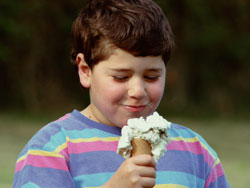![]()
Preventing Childhood Overweight and Obesity
To help your child maintain a healthy weight, balance the calories your child consumes from foods and beverages with the calories your child uses through physical activity and normal growth.
Remember that the goal for overweight and obese children and teens is to reduce the rate of weight gain while allowing normal growth and development. Children and teens should NOT be placed on a weight reduction diet without the consultation of a health care provider.
Balancing Calories: Help Kids Develop Healthy Eating Habits
One part of balancing calories is to eat foods that provide adequate nutrition and an appropriate number of calories. You can help children learn to be aware of what they eat by developing healthy eating habits, looking for ways to make favorite dishes healthier, and reducing calorie-rich temptations.
Encourage healthy eating habits.
 There's no great secret to healthy eating. To help your children and family develop healthy eating habits:
There's no great secret to healthy eating. To help your children and family develop healthy eating habits:
- Provide plenty of vegetables, fruits, and whole-grain products.
- Include low-fat or non-fat milk or dairy products.
- Choose lean meats, poultry, fish, lentils, and beans for protein.
- Serve reasonably-sized portions.
- Encourage your family to drink lots of water.
- Limit sugar-sweetened beverages.
- Limit consumption of sugar and saturated fat.
Remember that small changes every day can lead to a recipe for success!
Look for ways to make favorite dishes healthier.
The recipes that you may prepare regularly, and that your family enjoys, with just a few changes can be healthier and just as satisfying.
 Remove calorie-rich temptations!
Remove calorie-rich temptations!
Although everything can be enjoyed in moderation, reducing the calorie-rich temptations of high-fat and high-sugar, or salty snacks can also help your children develop healthy eating habits. Instead only allow your children to eat them sometimes, so that they truly will be treats! Here are examples of easy-to-prepare, low-fat and low-sugar treats that are 100 calories or less:
- A medium-size apple
- A medium-size banana
- 1 cup blueberries
- 1 cup grapes
- 1 cup carrots, broccoli, or bell peppers with 2 tbsp hummus
Balancing Calories: Help Kids Stay Active
Another part of balancing calories is to engage in an appropriate amount of physical activity and avoid too much sedentary time. In addition to being fun for children and teens, regular physical activity has many health benefits, including:
- Strengthening bones
- Decreasing blood pressure
- Reducing stress and anxiety
- Increasing self-esteem
- Helping with weight management
Help kids stay active.
Children and teens should participate in at least 60 minutes of moderate intensity physical activity most days of the week, preferably daily. Remember that children imitate adults. Start adding physical activity to your own daily routine and encourage your child to join you.
Some examples of moderate intensity physical activity include:
- Brisk walking
- Playing tag
- Jumping rope
- Playing soccer
- Swimming
- Dancing
 Reduce sedentary time.
Reduce sedentary time.
In addition to encouraging physical activity, help children avoid too much sedentary time. Although quiet time for reading and homework is fine, limit the time your children watch television, play video games, or surf the web to no more than 2 hours per day. Additionally, the American Academy of Pediatrics (AAP) does not recommend television viewing for children age 2 or younger. Instead, encourage your children to find fun activities to do with family members or on their own that simply involve more activity.
Why is childhood obesity considered a health problem?
Doctors and scientists are concerned about the rise of obesity in children and youth because obesity may lead to the following health problems:
- Heart disease, caused by:
- high cholesterol and/or
- high blood pressure
- Type 2 diabetes
- Asthma
- Sleep apnea
- Social discrimination
Childhood obesity is associated with various health-related consequences. Obese children and adolescents may experience immediate health consequences and may be at risk for weight-related health problems in adulthood.
Psychosocial Risks
Some consequences of childhood and adolescent overweight are psychosocial. Obese children and adolescents are targets of early and systematic social discrimination. The psychological stress of social stigmatization can cause low self-esteem which, in turn, can hinder academic and social functioning, and persist into adulthood.
Cardiovascular Disease Risks
Obese children and teens have been found to have risk factors for cardiovascular disease (CVD), including high cholesterol levels, high blood pressure, and abnormal glucose tolerance. In a population-based sample of 5- to 17-year-olds, almost 60% of overweight children had at least one CVD risk factor while 25 percent of overweight children had two or more CVD risk factors.
Additional Health Risks
Less common health conditions associated with increased weight include asthma, hepatic steatosis, sleep apnea and Type 2 diabetes.
- Asthma is a disease of the lungs in which the airways become blocked or narrowed causing breathing difficulty. Studies have identified an association between childhood overweight and asthma.
- Hepatic steatosis is the fatty degeneration of the liver caused by a high concentration of liver enzymes. Weight reduction causes liver enzymes to normalize.
- Sleep apnea is a less common complication of overweight for children and adolescents. Sleep apnea is a sleep-associated breathing disorder defined as the cessation of breathing during sleep that lasts for at least 10 seconds. Sleep apnea is characterized by loud snoring and labored breathing. During sleep apnea, oxygen levels in the blood can fall dramatically. One study estimated that sleep apnea occurs in about 7% of overweight children.
- Type 2 diabetes is increasingly being reported among children and adolescents who are overweight. While diabetes and glucose intolerance, a precursor of diabetes, are common health effects of adult obesity, only in recent years has Type 2 diabetes begun to emerge as a health-related problem among children and adolescents. Onset of diabetes in children and adolescents can result in advanced complications such as CVD and kidney failure.
In addition, studies have shown that obese children and teens are more likely to become obese as adults.
